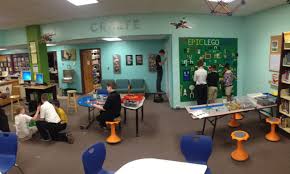As I read about the ways libraries promote infinite learning, I found myself thinking back to my early foundational experiences at the library as a young child. I remember that my mom and I would go to our local library and check out the maximum number of picture books possible on our library card. We’d then head home, pop some popcorn, and sprawl out on the living room floor, reading and snacking for endless hours. Then we’d repeat the process the next week. The library was one of my very favorite places to be, and I always looked forward to spending time there. In this way, the library served as a hub of learning for me, with a spoke connected directly to my home. My weekly visits to the library and my subsequent devouring of all the amazing books I brought home each week helped me develop a sense of wonder and curiosity, not to mention all the ways I was able to become a better reader in the process. My library was my classroom (to me, it was the very best kind of classroom, where I was free to explore and discover for myself), and I brought the spirit of that classroom home with me into my living room. That early memory that I have of bonding with my mom through our weekly haul of newly-discovered (or beloved repeats) of books will always be special to me. Of course, not everyone lives near enough to a public library to be able to visit as often as I had the privilege of doing, and that’s why I think it’s such an exciting time we live in today, where technological advances have ensured that the library can be everywhere and can reach people no matter where they live.
When I think about the idea of infinite learning as it relates to the school library, the idea of “library as classroom” is such a vital part of its function. The school library has the unique position of being located in a physical space with many other classrooms. What makes the school library special is that it has the opportunity to be the “classroom of classrooms”, so to speak, the one at the center of all the others, the heart of the school, the hub that connects a spoke to every other classroom. While younger students may remain in one classroom throughout the day, and older students have a handful of classrooms they cycle through, the library is the one that is for every single student in the school. It is there for everyone; it’s the constant that will continue to be there across the years while everything else in a student’s life is changing. It is both incredibly exciting and a bit daunting to think about all of the technology, the opportunities for programming, and the endless array of resources that can contribute to the school library’s role as the central classroom in the school. Being the decision-maker for what is included or offered in the library and what is not will certainly be a big responsibility. However, it’s comforting to consider that trial and error is part of the job, and that, yes, there are going to be some failures, but this is all part of the overall growth process. This particular quote really resonated with me: “It wouldn’t be library science without a little experimentation, and some of those experiments are going to fail. But occasionally, an idea is going to succeed. And when it does, it creates an opportunity to reshape the notion of what our libraries can do” (Greenwalt, 2013).

Image: National Education Association
Of course the school library’s continued existence relies heavily on the looming and ever-present issue of funding, which has lately been an issue of concern for many school librarians. It’s been disheartening for me to see so many school libraries lose funding, with trained librarians being replaced by hourly paraprofessionals, and hours for student usage of the library being cut short. It baffles and concerns me that school libraries are often the first up on the chopping block when the stream of funding starts to ebb; as the heart of information and learning in the school, the library is an invaluable resource that can never be replaced by Google. As school librarians, it is more important than ever to advocate for ourselves and the vital role we play in our students’ learning. Advocacy involves a high degree of reflecting on the work we do, defining our roles and what we hope to achieve, and being humble yet authentic as we talk about and promote the value of our library institutions (Stephens, 2016). In my future role, I hope to be able to lend my own voice to the school librarians who are bravely and vocally advocating for their programs and the value that they have as the heart of infinite learning in the school.

References
Greenwalt, R.T. (2013, February 21). Embracing the long game. Public Libraries Online. https://publiclibrariesonline.org/2013/02/embracing/
Stephens, M. T. (2016). The heart of librarianship : attentive, positive, and purposeful change. ALA Editions, an imprint of the American Library Association.
Hi Kristin,
I love the idea of a school library being the “classroom of classrooms” – it is such a clever way to put it! Like you, I loved borrowing books from the local public library and staying up with my sister to read in our shared room. Unfortunately, I never really had the same relationship with my school libraries. But I am happy to learn that someone like you (who is clearly very caring!) will work in the school library sphere and tech children the joy of learning through books. Wonderful post!